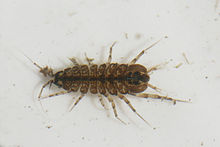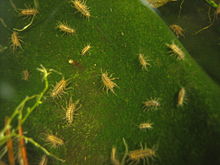Asellus aquaticus
| Asellus aquaticus | |
|---|---|

| |

| |
| Scientific classification | |
| Kingdom: | |
| Phylum: | |
| Subphylum: | |
| Class: | |
| Order: | |
| Family: | |
| Genus: | |
| Species: | A. aquaticus
|
| Binomial name | |
| Asellus aquaticus | |
Asellus aquaticus is a freshwater crustacean resembling a woodlouse. It is known by common names including "waterlouse", "aquatic sowbug" and "water hoglouse".
Ecology
"Scud fly" is common throughout the temperate zone including Europe, Russia, and North America.[1] Asellus aquaticus is found in rivers, streams and standing water particularly where there are plenty of stones under which it hides although not where the water is strongly acidic.[2] It is omnivorous.[2]
Asellus aquaticus is relatively tolerant of a range of pollutants and has been used as an indicator of water quality.[1]
Life Cycle and Reproduction
Asellus aquaticus can breed throughout the year, if the temperature is high enough; they do not breed under cold temperatures. Maturity can be reached in few months under warm summer temperatures, but maturation may take as much as two years in permanently cold water bodies (e.g., high-latitude or mountain waters).[3] Life span varies similarly: from 9 months in South Africa to 20 months in Northern Europe. Females carry eggs in brood pouches underneath their body.[4]
Conservation
A number of subspecies are considered to be endangered including:
- Asellus aquaticus carniolicus, endemic to Slovenia.[5]
- Asellus aquaticus cavernicolus found only in Italy and Slovenia.[6]
- Asellus aquaticus cyclobranchialis, endemic to Slovenia.[7]
References
- ^ a b Lorraine Maltby (1991). "Pollution as a probe of life-history adaptation in Asellus aquaticus (Isopoda)". Oikos. 61 (1): 11–18. JSTOR 3545402.
- ^ a b Brian A. Whitton (1982). Rivers, Lakes and Marshes. London: Hodder & Stoughton. p. 131. ISBN 0-340-23155-6.
- ^ Karen Anna Økland (1978). "Life history and growth of Asellus aquaticus (L.) in relation to environment in a eutrophic lake in Norway". Hydrobiologia. 59 (3): 243–259. doi:10.1007/BF00036504.
- ^ P. Sterry (1997). Complete British Wildlife. Collins. p. 212. ISBN 0-583-33638-8.
- ^ Template:IUCN2009.2
- ^ Template:IUCN2009.2
- ^ Template:IUCN2009.2
